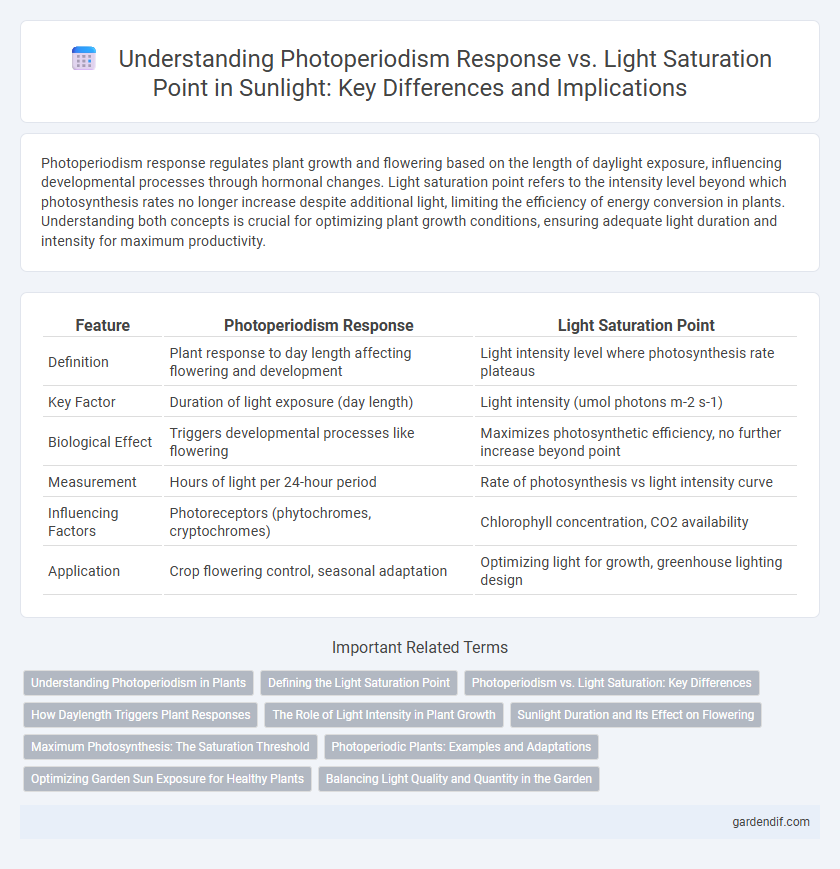
Photoperiodism Response vs Light Saturation Point Illustration
Photoperiodism response regulates plant growth and flowering based on the length of daylight exposure, influencing developmental processes through hormonal changes. Light saturation point refers to the intensity level beyond which photosynthesis rates no longer increase despite additional light, limiting the efficiency of energy conversion in plants. Understanding both concepts is crucial for optimizing plant growth conditions, ensuring adequate light duration and intensity for maximum productivity.
Table of Comparison
| Feature | Photoperiodism Response | Light Saturation Point |
|---|---|---|
| Definition | Plant response to day length affecting flowering and development | Light intensity level where photosynthesis rate plateaus |
| Key Factor | Duration of light exposure (day length) | Light intensity (umol photons m-2 s-1) |
| Biological Effect | Triggers developmental processes like flowering | Maximizes photosynthetic efficiency, no further increase beyond point |
| Measurement | Hours of light per 24-hour period | Rate of photosynthesis vs light intensity curve |
| Influencing Factors | Photoreceptors (phytochromes, cryptochromes) | Chlorophyll concentration, CO2 availability |
| Application | Crop flowering control, seasonal adaptation | Optimizing light for growth, greenhouse lighting design |
Understanding Photoperiodism in Plants
Photoperiodism in plants is a crucial physiological response to the duration of light and dark periods, regulating flowering and growth cycles. This mechanism differs from the light saturation point, which refers to the intensity of sunlight beyond which photosynthesis no longer increases. Understanding photoperiodism helps optimize agricultural practices by manipulating light exposure to control plant development stages effectively.
Defining the Light Saturation Point
The light saturation point is the intensity of sunlight at which photosynthesis reaches its maximum rate and further increases in light intensity do not enhance the photosynthetic output. Unlike photoperiodism response, which involves plant developmental changes based on day length, the light saturation point specifically refers to the threshold of light intensity needed for optimal photosynthetic efficiency. Understanding this concept is crucial for optimizing plant growth conditions and improving agricultural productivity.
Photoperiodism vs. Light Saturation: Key Differences
Photoperiodism is the biological response of plants to the relative lengths of day and night, regulating flowering and growth cycles based on light duration. In contrast, the light saturation point refers to the intensity of sunlight at which a plant's photosynthesis rate reaches its maximum and cannot increase further despite additional light. Understanding photoperiodism versus light saturation highlights how plants optimize development through day length cues versus photosynthetic efficiency under varying sunlight intensities.
How Daylength Triggers Plant Responses
Photoperiodism response in plants is triggered by the length of day and night, regulating flowering and growth cycles through the detection of critical light periods. This response is controlled by phytochromes that sense changes in light duration, enabling plants to optimize reproductive timing. In contrast, the light saturation point defines the maximum light intensity a plant can utilize for photosynthesis, unrelated to daylength but crucial for energy capture efficiency.
The Role of Light Intensity in Plant Growth
Light intensity directly influences the photoperiodism response by regulating the duration and quality of light exposure that controls flowering and other developmental processes in plants. The light saturation point denotes the intensity at which photosynthesis reaches its maximum rate, beyond which increased light no longer enhances plant growth. Optimizing light intensity ensures efficient photosynthetic activity while triggering appropriate photoperiodic cues, vital for maximizing crop yield and physiological adaptation.
Sunlight Duration and Its Effect on Flowering
Sunlight duration directly influences photoperiodism response, where specific lengths of daylight trigger flowering in plants, categorized as short-day, long-day, or day-neutral species. The light saturation point represents the maximum intensity of sunlight beyond which photosynthesis rates no longer increase, but it does not affect the timing of flowering controlled by photoperiodism. Understanding the balance between sunlight duration and intensity allows optimization of flowering cycles in horticulture and agriculture.
Maximum Photosynthesis: The Saturation Threshold
Photoperiodism response regulates plant development based on day length, but maximum photosynthesis is constrained by the light saturation point where increasing light intensity no longer boosts photosynthetic rate. At this saturation threshold, the photosynthetic apparatus operates at full capacity, and further light does not enhance carbon fixation or growth. Understanding this distinction helps optimize sunlight exposure in agriculture to maximize crop yield without wasteful light application.
Photoperiodic Plants: Examples and Adaptations
Photoperiodic plants such as soybeans, wheat, and chrysanthemums regulate their flowering based on day length, demonstrating distinct short-day, long-day, and day-neutral adaptations essential for seasonal growth cycles. These plants possess molecular mechanisms involving phytochrome pigments that detect changes in light duration, triggering developmental processes aligned with optimal environmental conditions. Contrastingly, the light saturation point refers to the intensity at which photosynthesis reaches its maximum rate, varying among species and influencing overall growth but is independent of photoperiodic control.
Optimizing Garden Sun Exposure for Healthy Plants
Photoperiodism response in plants regulates growth and flowering based on day length, requiring precise light durations for optimal development. The light saturation point represents the maximum sunlight intensity a plant can utilize for photosynthesis before energy efficiency plateaus. Optimizing garden sun exposure involves balancing photoperiodic needs with light saturation thresholds to maximize photosynthetic activity and promote healthy, vigorous plant growth.
Balancing Light Quality and Quantity in the Garden
Photoperiodism response in plants regulates flowering and growth cycles based on day length, directly impacting their developmental stages. Light saturation point defines the maximum light intensity beyond which photosynthesis rates plateau, preventing further energy gains despite increased light. Balancing light quality and quantity ensures optimal photosynthetic efficiency and healthy plant development, maximizing garden productivity by tailoring light exposure to species-specific photoperiodic and saturation thresholds.
Photoperiodism Response vs Light Saturation Point Infographic

 gardendif.com
gardendif.com